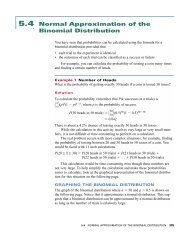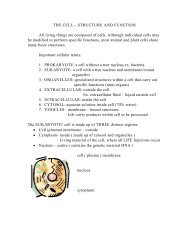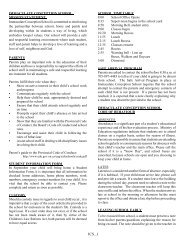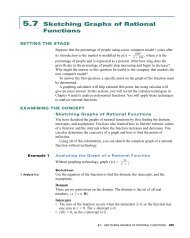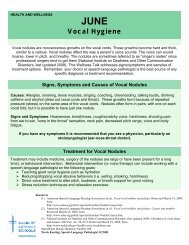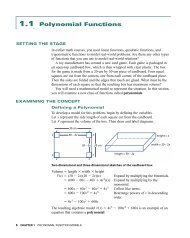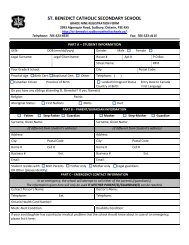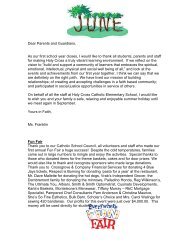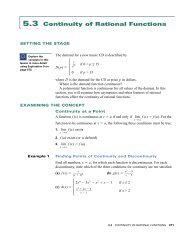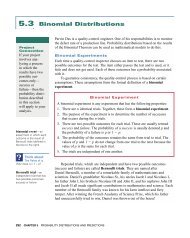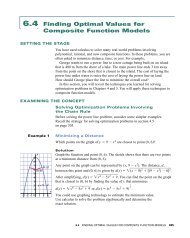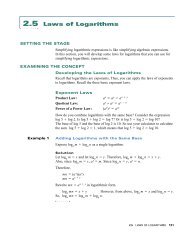Intervals of Increase and Decrease
Intervals of Increase and Decrease
Intervals of Increase and Decrease
Create successful ePaper yourself
Turn your PDF publications into a flip-book with our unique Google optimized e-Paper software.
10. A plastic pop bottle holds 2 L <strong>of</strong> liquid. In an experiment, a small hole is<br />
drilled in the bottom <strong>of</strong> the bottle. The volume <strong>of</strong> liquid, V, remaining<br />
t t2<br />
after t seconds can be modelled by V(t) 2 5 2 , where t ≥ 0.<br />
00<br />
(a) How long does it take for the 2 L <strong>of</strong> liquid to drain from the bottle?<br />
(b) Verify that the volume <strong>of</strong> liquid is always decreasing until the bottle is<br />
empty.<br />
4<br />
y<br />
11. Communication: Identify the intervals on which the function shown on the<br />
left is increasing or decreasing.<br />
3<br />
2<br />
1<br />
12. A slow-pitch pitcher lobs the ball toward home plate. The height <strong>of</strong> the ball<br />
in metres, h, at t seconds can be modelled by h(t) 4.9t 2 10.5t 0.2.<br />
(a) When is the height <strong>of</strong> the ball increasing? decreasing?<br />
(b) When is the velocity <strong>of</strong> the ball increasing? decreasing?<br />
–2 –1<br />
–1<br />
1 2<br />
x<br />
13. Application: The pr<strong>of</strong>it, P, in dollars for selling x hamburgers is modelled<br />
x2<br />
by P(x) 2.44x 20<br />
5000, where 0 ≤ x ≤ 35 000. For what<br />
000<br />
quantities <strong>of</strong> hamburgers is the pr<strong>of</strong>it increasing? decreasing?<br />
–2<br />
14. Graph f if f ′(x) < 0 when x < 2 <strong>and</strong> when x > 3, f ′(x) > 0 when<br />
2 < x < 3, <strong>and</strong> f (2) 0 <strong>and</strong> f (3) 5.<br />
15. Graph f if f ′(x) > 0 when x < 3 <strong>and</strong> when x > 1, f ′(x) < 0 when<br />
3 < x < 1, <strong>and</strong> f (3) 4 <strong>and</strong> f (1) 2.<br />
16. Use an example to show <strong>and</strong> verify the following: If functions f <strong>and</strong> g are<br />
increasing on an interval I, then f g must also be increasing on I.<br />
17. The world population from 1900 to 2000 can be modelled by<br />
P(t) 0.0012t 3 0.3197t 2 0.2109t 1688.951, where P is the<br />
population in millions <strong>and</strong> t is the number <strong>of</strong> years since 1900. Did the<br />
world population ever decrease in the 20th century? Justify your answer.<br />
18. Thinking, Inquiry, Problem Solving: After birth, a baby normally loses<br />
weight for a few days <strong>and</strong> then starts gaining. The table shows an infant’s<br />
weight during the first two weeks.<br />
Day 0 1 2 3 4 5 6 7 8 9 10 11 12 13 14<br />
Weight (kg) 3.14 3.03 2.95 2.80 2.77 2.76 2.79 2.84 2.93 2.95 3.01 3.14 3.32 3.49 3.68<br />
C<br />
Determine the best polynomial model for this data. Use your model to find<br />
the intervals on which the infant’s weight is increasing <strong>and</strong> decreasing.<br />
19. Check Your Underst<strong>and</strong>ing: A rock is thrown into the air from a bridge.<br />
Verify that its height decreases over the interval 1 < t < 2.2. The height <strong>of</strong><br />
the rock above the water, h, in metres at t seconds is modelled by<br />
h(t) 4.9t 2 9.8t 2.1.<br />
20. Determine the intervals in which f (x) ⏐x 2⏐ 3 increases <strong>and</strong><br />
decreases.<br />
4.1 ANALYZING A POLYNOMIAL FUNCTION: INTERVALS OF INCREASE AND DECREASE 275



